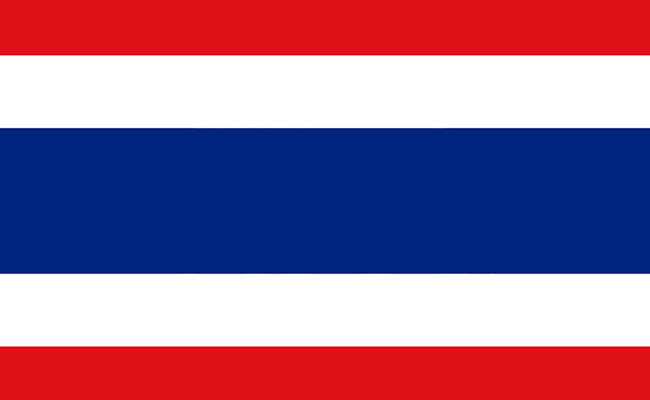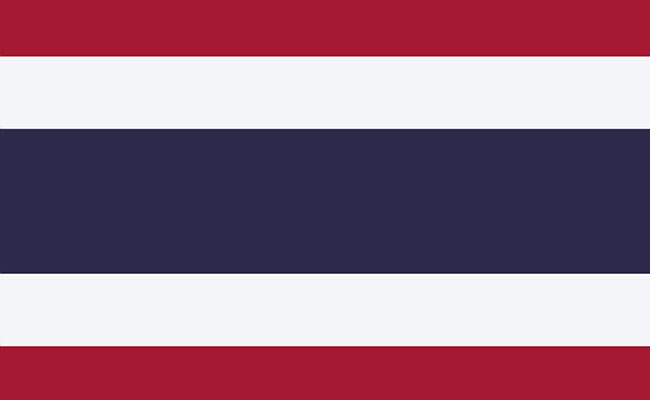Thailand's flag, known as ธงไตรรงค์ (thong trai rong), features a bold, horizontal tricolor of red, white, and blue stripes. Red signifies the nation and people, white represents purity and religion, and the central blue stripe, twice as wide, honors the monarchy.
Historical Beginnings
The flag's origins date back to the 17th century (Ayutthaya period) during the reign of King Narai when Siam, as Thailand was known then, likely used a plain red flag for representation.
As the nation evolved, so did its symbols.
The first significant change came in 1782 when a white chakra, the symbol of the ruling Chakri dynasty, was added to the state and naval flag.
A subtle change in 1817 saw a white elephant added to the center of the chakra, a change issued by Buddha Loetla Nabhalai (Rama II).
By 1855, the chakra was dropped for just a white elephant on a red background, decreed by Mongkut (Rama IV). Traditionally, the white elephant is associated with royalty and considered a symbol of power, prosperity, and good fortune.
1893 brought another change in design. Here we see the white elephant in full caparison.
Modern Transformation
The elephant emblem was replaced on November 21, 1916, with two horizontal white stripes set against a red background.
Later, on September 28, 1917, the central red stripe underwent a transformation, changing to a vibrant shade of blue.
The current design we see today was issued by King Vajiravudh (Rama VI), during a period when Thailand, as an ally of Britain, France, Russia, and the United States in World War I, sought to modernize its flag for global recognition. The new design incorporated the “colors of liberty” used by the allied nations, symbolizing Thailand's trading relationship with the West and its status as a modern nation.
Notably, the blue has somewhat of an indigo / purple tone to it, which at the time was the Thai auspicious color for Saturday, the day King Vajiravudh was born.

Five horizontal stripes of red, white, blue, white and red, the middle stripe twice as wide as the other stripes. The flag has a width-to-length ratio of 2 to 3.
In 2017, a new version of the flag was issued, with slightly darker colors, though it is common to see the previous version still in use.
Symbolism and Meaning
The three colors of the Thai flag carry significant meaning:
- Red represents the land and people of Thailand, signifying the blood shed for the nation's independence.
- White symbolizes the purity of Buddhism, the country's main religion, and the religious laws that guide the people.
- Blue stands for the monarchy, which has been a unifying and guiding force for the country.
The flag's colors also align with the unofficial motto of Thailand: nation-religion-king, encapsulating the core values that define Thai society.
Standardization and Celebration
The design and colors of the flag were fully standardized in 1979, with precise specifications laid out for its construction. The centennial of the flag's adoption was marked in 2017, further solidifying its importance in the national consciousness.
The Thai flag is not just a national symbol but also a representation of the country's history, culture, and aspirations. It stands as a reminder of the unity and resilience of the Thai people, their reverence for religious and monarchical institutions, and their pride in their nation's sovereignty.
Thailand's Maritime Flags
The naval ensign of the Royal Thai Navy (RTN) features the national flag with a distinctive red circle in the center. Within this circle is the historically featured white elephant in full caparison facing the hoist. This ensign was adopted on 28 September 1917.
The naval jack of Thailand is similar to the national flag but includes the Royal Thai Navy emblem in the center. Both the ensign and the jack carry the same colors as the national flag, representing the nation, religion, and monarchy. These maritime flags reflect the country's respect for its naval forces and the historical significance of the monarchy in Thai culture.
Start with a quick quote here from Cigna. Then you can compare it to other companies. If you are sending money to your loved one, or your own Thai bank account, try Wise here. It is fast and cheap. Me and the majority of my readers are using it. Learning Thai makes life easier, and way more fun. I use Thaipod101. Get a free account by clicking here. It is really easy to use.More Tips for a Better Life in Thailand
Get Good Health Insurance:
Send Money to Thailand:
Improve Your Thai Skills:
Last Updated on












Richard says
Jun 30, 2024 at 12:07 am
Steve says
May 24, 2024 at 2:50 am
Graham says
A very interesting and imoortant article on the history of the Thai flag. Congratulations.
May 23, 2024 at 8:27 am
TheThailandLife says
May 23, 2024 at 6:03 pm